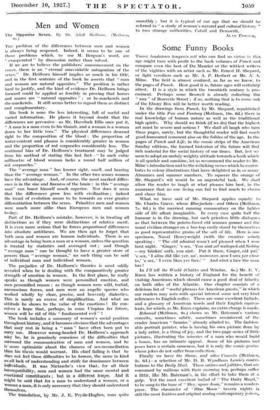Men and Women
Tun problem of the differences between men and women is. always being reopened. Indeed, it seems to be one of those problems which, to use M. Bergson's word, are ‘7 exasperated" by discussion rather than solved.
If we are to believe the publishers' announcement on the Caver, there is an "eternal unavoidable antagonism of the sexes." Dr. Heilborn himself implies as much in his title, and in the first sentence of the book he asserts that "man and woman are natural opposites." The position is rather hard to justify, and the kind of evidence Dr. Heilborn brings forward could be applied as forcibly in proving that horses and mares are "natural opposites " ; or he-mackerels and she-mackerels. It still seems better to regard them as distinct and complementary.
His book is none the less interesting, full of useful and varied information. He places it beyond doubt that the differences are pervasive—as Mr. Havelock Ellis once put it, "A man is a man even to his thumb, and a woman is a woman down to her little toes." The physical differences descend right to the composition of the blood : the proportion of water-content and plasma is considerably greater in women and the proportion of red corpuscles considerably less. The continual bias of Dr. Heilborn's treatment may be judged from his method of stating this last fact—" In each cubic millimetre of blood woman lacks a round half million of red corpuscles."
The "average man" has keener sight, smell, and hearing than the "average woman." In the other two senses women have the advantage. And, of course, the most marked differ- ence is in the size and fineness of the brain : in this "average man" can boast himself much superior. Nor does it seem that the differences grow less with civilization ; indeed the trend of evolution seems to be towards an ever greater differentiation between the sexes. Primitive men and women were much more alike than European men and women to-day.
Part of Dr. Heilborn's mistake, however, is in treating all distinctions as if they were distinctions of relative merit. It is even more serious that he forces proportional differences into absolute antitheses. We are then apt to forget that both men and women are human individuals. There is no advantage in being born a man or a woman, unless the question is treated by statistics and averaged out; and though "average man" can be thought to have a greater store of powers than "average woman," no such thing can be said of individual man and individual woman.
The prejudice of Dr. Heilborn's theories is most oddly revealed when he is dealing with the comparatively greater strength of emotion in women. In the first place, he really speaks as though women were personified emotion, and men personified reason ; as though women were wild, turbid, unconscious forces, and men were an angelic species who Worked wholly by clear, precise, and heavenly dialectics. This is surely an excess of simplification. And what an attitude he shows to the value of the emotions ! He con- ceives a hope that, perhaps, in some Utopian far future, women will be rid of this "fundamental evil " !
The book includes a summary of women's social position throughout history, and it beedthes obvious that the advantages that may rest in being a " man " have often been put to wily use. However wrong-headed Dr. Heilborn's approach pity be, be is genuinely conscious of the difficulties that siirround the communication of men and women, and he is'', more optimistic about the chances of sex-reconciliation than his thesis would warrant. His chief failing is that he does not feel these difficulties to be human, the same in kind as all lack of understanding and strife for dominance between uhividuals., was Nietzsche's view that, for all their incompatibility, men and women had the same mental and eTnOtional constituents ; but in a different tempo. And it iritht be said that for a man to understand a woman, or a WOrnan a man, it is only necessary that they should understand themselves.
The IratislatIon", by Mr. J. R. Tryder-Ifuglies, runS quite smoothly ; but it is typical of our age that we should be referred in "a study of woman's natural and cultural history ". to two strange authorities, Catull and Dernoerit.
ALAN PORTER.










































 Previous page
Previous page